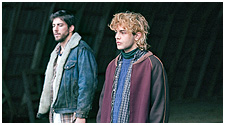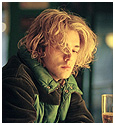|
|
|
| Xavier Dolan über seinen Film |
|
| Nachdem ich unbeabsichtigt eine Trilogie über das Thema der unmöglichen Liebe geschaffen hatte (I KILLED MY MOTHER, HERZENSBRECHER und LAURENCE ANYWAYS), war ein Richtungswechsel fällig. Mehrere Möglichkeiten boten sich an. Ich öffnete meine Schublade voller Notizzettel und Servietten, vollgekritzelt mit Ideen, Dialogen, und zwei oder drei Anreißern, wie man sie in Fernsehzeitschriften findet. Es gab einen politischen Thriller und meinen ersten englischsprachigen Film, THE DEATH AND LIFE OF JOHN F DONOVAN; aber ich wollte etwas schreiben, das ich sofort machen konnte. Ich brauchte etwas Blitzschnelles, für einen ebenso schnellen Dreh. |
|
| Dann erinnerte ich mich an das Stück TOM AT THE FARM. Es war im Winter 2011, und die Produktionsvorbereitung für LAURENCE ANYWAYS hatte begonnen. In dieser Nacht hielt Lise Roy - die später auch im Film die Rolle spielen sollte - den Monolog einer Mutter, die lang gelitten hat, vom Begräbnis ihres Sohns heimkehrt und bei der Zubereitung eines Nudelsalats zusammenbricht, für den sie berühmt ist. Sie wirft den ganzen Salat in den Müll - keiner hat einen Bissen genommen - und lässt ihrem Ekel über das Rezept und all die Leute um sie herum freien Lauf, die sie all die Jahre zwangen, ihn zu machen. Der Nudelmonolog blieb immer beim Thema, also dem Essen, aber er deutete die tiefe Trauer einer Frau an, die nie etwas anderes als den Hof gekannt hat und die flüchtigen Umarmungen ihres verstorbenen Mannes und ihrer Söhne, das Melken der Kühe, und die leere Resignation, wenn man die Schotterstraße hinabsieht und begreift, dass sie nie jemand verdunkeln wird. Ironischerweise schaffte es genau dieser Augenblick nicht in den Film, vielleicht weil er zu theatralisch war. |
|
| Doch diese Abzweigung ins mütterliche Unglück hatte zu nah bei mir eingeschlagen, als dass ich diesen Weg nicht weiterverfolgt hätte. Der Autor des Stücks, Michel Marc Bouchard, ist sehr gut darin, sowohl den Standpunkt des Gastes wie der Gastgeber auszudrücken, und er vermeidet festgefahrene Stadt-vs-Land-Klischees. Die Brutalität des Verhältnisses zwischen den beiden männlichen Hauptdarstellern, elegant und ästhetisch auf der Bühne, versprach bereits eine Rauheit und Gewalttätigkeit, die ich filmisch ausdrücken wollte und mit der ich das vertraute Terrain hinter mir lassen würde. Ich fühlte, dass diese Empfindung von Angst, Beklemmung und Fremdheit für die große Leinwand gemacht waren, und vor allem, dass das Neue daran genau das war, was ich zu finden hoffte. |
|
Nach der Vorführung, im Dunst verdienter Zigaretten,
fragte ich Michel Marc, wer das Stück verfilmen würde.
Er sagte: „Niemand, warum? Denkst du an jemand Bestimmten?”
„Ja, mich”, antwortete ich mit der ganzen Bescheidenheit von Nero in BRITANNICUS.
Aber im Ernst, so war das im Großen und Ganzen ... |
| From Stage To Screen |
|
| In 2011, when Michel Marc Bouchard and I decided to adapt his play together, it was determined that we would each work on our own. He would send me a first draft that I would then work on, I would send him a second draft, and so on. |
|
| Laurence Anyways having been shot and produced over a period of two years, I was back from Cannes in May of 2012 and had to quickly find a project for the fall. Pierre Falardeau, the late Quebecois filmmaker, said that it was better to shoot then to shoot yourself in the foot, and I was ready to rediscover the rush of the set. Tom at the Farm became this urgent autumn project, and I soon called Michel Marc to tell him cameras would roll in October. He was completely swamped with writing a new play, and revisions on the script Queen Christina. Thus the adaptation began immediately, and Michel Marc and I tossed the ball back and forth for a month or two. |
|
| In the play, there were only 4 characters: Tom, Francis, Agathe and, at the very end, Sara, who arrives like truth wrapped up in lies, like a deliverance, a spark in a room filled with gas. They shared only a kitchen, a barn and a bedroom; a classic no exit. We had to play this claustrophobic card in the film, but in such a way that the audience would not grow tired of seeing the same sets and people over and over again. It occurred to me early on that we would need to remove Tom from the farm a couple of times, if only to amp up the fear that he would return. The funeral, a visit to the doctor and the memories of a bar-brawl, would provide us with a few breaths of fresh air, and the chance to see Tom interact with characters who were not so central to his consenting captivity. |
|
| Enough characters, enough chances at least to escape his destiny. Chances he would not take. There were 10 scenes in the play ; 113 in the film. Choices had to be made - uneasy ones. But from all those play-toscript sacrifices, one thing - one, really - was left behind that I can´t forget about as I am truly melancholic it didn´t make the cut. It was a quote from the author´s foreword, and taken out of context, it probably would have been pretentious and highly on-the-nose to have any character merely speak it. It is by far the last angle I’d choose for this film, mostly because there is nothing I want more than to avoid ghettos and labels that do nothing but stress the "issue", but that quote, that phrase spanned to herself the movie´s complete emotional range, its fragility, its timeless problematics, as well as its dormant disposition for the deviant and unseemly. It was, all things considered, what Tom ... was all about. That and so many other things, but THAT, first and foremost, I guess: |
|
| "Before learning how to love, homosexuals learn how to lie." |
|
| — Michel Marc Bouchard - |
| Working with Gabriel Yared |
|
| Initially, there was to be no music in Tom at the Farm . My obsession with "massive change" was pushing me to want a crushing silence, from which would emerge, according to my theory, a superior tension. I said to myself: howling wind, creaking floorboards: that´s my passport to terror. And yet, as soon as I got into the editing room, I was going from Philip Glass, James Newton Howard, and even - why not? - Hans Zimmer, carpeting about 150% of the movie in heavy instrumentation as Tom screamed out his need for music. |
|
| As I promised myself, pop songs would play only on the radio or in bars. At a private screening, Suzanne Clement noticed that the one musical digression I had allowed myself felt "too me". I ultimately changed it, honouring my original intent, and removed the song that turned the scene into a music video. It was for the best. So we came to the problem of the score. What seemed like the most important thing in the world at that moment, had never been part of the plan. After a conversation with my co-producers, it was decided we needed a composer. "Ideally, the best one in the world," I suggested. Gabriel Yared received the DVD of Tom at the Farm, and watched my other films with all the simplicity and attention to detail of an artist that we admire, and who´s attitude and aesthetic does justice to their lofty reputation. Against all odds, he accepted. |
|
| He accepted, and his first few demos were like a bomb being dropped on me. A bomb that dragged everything in its wake - doubt, debris, boredom - and cleared the slate. I had already abandoned my film to write something new, and act in a movie shooting in the spring - I was imagining new projects, something far sexier and easier than finishing old ones, or fine-tuning a movie I thought was, honestly, just ok. I never met Gabriel Yared. I only ever heard his voice on the telephone. But I met his music, his work, and the enormity of his imagination. His lyrical, confident interpretation and appropriation of the romantic-panic genre was by turns Hitchcockian and Mahleresque. I understood the style of this man through his baroque extravagances - though I think he was just following his own instinctive impulses - and his ability, his ease with accepting the classicism when it was called for, giving the movie its sensuality, its breath. In fact, watching TOM AT THE FARM with the score in place, I loved it for the first time. I was proud. I regained confidence in the film, and the rest of the production followed, the sound design, mix, colour correcting, with their respective talents who would re-invent the film themselves, as if all Tom was waiting for was them. I wanted to share the way in which this particular collaboration helped put things in perspective for me. |
|



